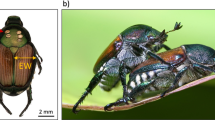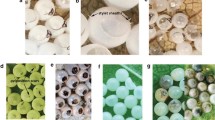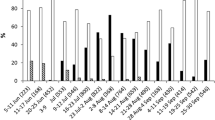Abstract
Inundative releases of Trichogramma minutum Riley were made in a commercialblueberry field in British Columbia, Canada, todetermine the extent of dispersal of adult wasps, andto determine whether complete parasitism of eggswithin egg masses of the target host [oblique-bandedleafroller (OBLR), Choristoneura rosaceana(Harris)] occurred. Three weekly releases of waspswere made from a single release point in the center ofeach field during the flight of first generation OBLRadults. Sticky trap, sentinel egg mass andtarget-host egg mass data all indicated only a limitedrange of dispersal of T. minutum within thefield. In addition, only partial parasitism of eggmasses of the target host occurred even in closeproximity to the release point. We discuss theimportance of determining the response of Trichogramma females to previously-parasitized eggswhen using Trichogramma wasps for biologicalcontrol of lepidopterous species that oviposit largeegg masses.
Similar content being viewed by others
References
Anonymous, 1996. Berry Production Guide for Commercial Growers. 1996/97 edition. Province of British Columbia, Ministry of Agriculture, Fisheries and Food, Victoria, BC, Canada.
Bigler, F., B.P. Suverkropp and F. Cerutti, 1997. Host searching by Trichogramma and its implications for quality control and release methods. In: D.A. Andow, D.W. Ragsdale and R.F. Nyall (eds.), Ecological Interactions and Biological Control. Westview Press. pp. 240–253.
Dijken, M.J. and J.K. Waage, 1987. Self and conspecific superparasitism by the egg parasitoid Trichogramma evanescens. Entomol.Exp.Appl. 43: 183–192.
Flanders, S.E., 1930. Mass production of egg parasites of the genus Trichogramma. Hilgardia 4: 465–501.
Glenn, D.C. and A.A. Hoffmann, 1997. Developing a commercially viable system for biological control of light brown apple moth (Lepidoptera: Tortricidae) in grapes using endemic Trichogramma (Hymenoptera: Trichogrammatidae). J.Econ.Entomol. 90: 370–382.
Godfray, H.C.J., 1994. Parasitoids: Behavioural and Evolutionary Ecology. Princeton University Press, Princeton, NJ.
Hemerik, L., G. Driessen and P. Hacou, 1993. Effects of intra-patch experiences on patch time, search time and searching efficiency of the parasitoid Leptopilina clavipes (Hartig). J.Anim.Ecol. 62: 33–44.
Hendricks, D.E., 1967. Effects of wind on dispersal of Trichogramma semifumatium. J.Econ.Entomol. 60: 1367–1373.
Kanour, W.W. and P.P. Burbutis, 1984. Trichogramma nubilale (Hymenoptera: Trichogrammatidae) field releases in corn and a hypothetical model for control of European corn borer (Lepidoptera: Pyralidae). J.Econ.Entomol. 77: 103–107.
Keller, M.A. and W.J. Lewis, 1985. Movements of Trichogramma pretiosum (Hymenoptera: Trichogrammatidae) released into cotton. Southwestern Entomol.Suppl. 8: 99–109.
Klomp, H., B.J. Teerink and W.C. Ma, 1980. Discrimination between parasitized and unparasitized hosts in the egg parasite Trichogramma embryophagum (Hymenoptera: Trichogrammatidae): a matter of learning and forgetting. Neth.J.Zool. 30: 254–277.
van Lenteren, J.C., 1991. Encounters with parasitized hosts: to leave or not to leave a patch. Neth.J.Zool. 41: 144–157.
Li, C., B.D. Roitberg and M. Mackauer, 1993. Patch residence time and parasitism of Aphelinus asychus: a simulation model. Ecol.Model. 69: 227–241.
Li, L.Y., 1994. Worldwide use of Trichogramma for biological control on different crops: a survey. In: E. Wajnberg and S.A. Hassan (eds.), Biological Control with Egg Parasitoids. C.A.B. International, Oxon, UK. pp. 37–54.
Li, S.Y. and S.M. Fitzpatrick, 1997. Monitoring obliquebanded leafroller (Lepidoptera: Tortricidae) larvae and adults on raspberries. Environ.Entomol. 26: 170–177.
McGregor, R, T. Hueppelsheuser, A Luczynski and D.E. Henderson, 1998. Collection and evaluation of Trichogramma species (Hymenoptera: Trichogrammatidae) as biological controls of the oblique-banded leafroller, Choristineura rosaceana (Harris) (Lepidoptera: Tortricidae) in raspberries and blueberries. Biol.Contr. 11: 38–42.
Miura, K., S. Matsuda and M. Kobayashi, 1994. Discrimination between parasitized and unparasitized eggs in an egg parasitoid, Trichogramma chilonis Ishi (Hymenoptera: Trichogrammatidae). Appl.Entomol.Zool. 29: 317–322.
Roitberg, B.D., M. Mangel, R.G. Lalonde, C.A. Roitberg, J.J.M. van Alphen and L.E.M. Vet, 1992. Seasonal dynamic shifts in patch exploitation by parasitic wasps. Behav.Ecol. 3: 156–165.
Smith, S.M., 1988. Pattern of attack on spruce budworm egg masses by Trichogramma minutum (Hymenoptera: Trichogrammatidae) released in forest stands. Environ.Entomol. 17: 1009–1015.
Smith, S.M., 1996. Biological control with Trichogramma: advances, successes, and potential for their use. Annu.Rev.Entomol. 41: 375–406.
Susuki, Y., H. Tsuji and M. Sasakawa, 1984. Sex allocation and effects of superparasitism on secondary sex ratios in the gregarious parasitoid, Trichogramma chilonis (Hymenoptera: Trichogrammatidae). Anim.Behav. 32: 478–484.
Visser, M., J.J.M. van Alphen and H.W. Nell, 1992a. Adaptive superparasitism and patch time allocation in solitary parasitoids: the influence of pre-patch experience. Behav.Ecol.Sociobiol. 31: 163–171.
Visser, M., J.J.M. van Alphen and L. Hemerik, 1992b. Adaptive superparasitism and patch time allocation in solitary parasitoids: an ESS model. J.Anim.Ecol. 61: 93–101.
Wilkinson, L., M. Hill, J.P. Welna and G.K. Birkenbeuel, 1992. SYSTAT for Windows, Version 5. SYSTAT Inc., Evanston, IL.
Yu, D.S.K., J.E. Laing and E.A.C. Hagley, 1984. Dispersal of Trichogramma spp. (Hymenoptera: Trichogrammatidae) in an apple orchard after inundative releases. Environ.Entomol. 13: 371–374.
Author information
Authors and Affiliations
Corresponding author
Rights and permissions
About this article
Cite this article
McGregor, R., Caddick, G. & Henderson, D. Egg loads and egg masses: Parasitism ofChoristoneura rosaceana eggs by Trichogramma minutum after inundativerelease in a commercial blueberry field. BioControl 45, 257–268 (2000). https://doi.org/10.1023/A:1009922101934
Issue Date:
DOI: https://doi.org/10.1023/A:1009922101934




